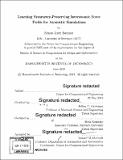| dc.contributor.advisor | Jeffrey C. Grossman and Boris Kozinsky. | en_US |
| dc.contributor.author | Batzner, Simon Lutz. | en_US |
| dc.contributor.other | Massachusetts Institute of Technology. Computation for Design and Optimization Program. | en_US |
| dc.date.accessioned | 2019-10-11T22:00:17Z | |
| dc.date.available | 2019-10-11T22:00:17Z | |
| dc.date.copyright | 2019 | en_US |
| dc.date.issued | 2019 | en_US |
| dc.identifier.uri | https://hdl.handle.net/1721.1/122525 | |
| dc.description | Thesis: S.M., Massachusetts Institute of Technology, Computation for Design and Optimization Program, 2019 | en_US |
| dc.description | Cataloged from PDF version of thesis. | en_US |
| dc.description | Includes bibliographical references. | en_US |
| dc.description.abstract | Machine-Learning Interatomic Force-Fields have shown great promise in increasing time- and length-scales in atomistic simulations while retaining the high accuracy of the reference calculations that they are trained on. Most proposed models aim to learn the potential energy surface of a system of atoms as a function of atomic coordinates and species and obtain the forces acting on the atoms as the negative of the gradient of the global energy with respect to the atomic positions. For the time evolution of an atomistic system in molecular dynamics, however, only atomic forces are required. This thesis examines the construction of a direct approach for learning atomic forces, thereby bypassing the need for learning an energy-based model. Predicting atomic forces directly requires the careful consideration of incorporating the symmetries of 3D space into the model. The construction of an efficient, direct, and symmetry-preserving deep learning model that can predict atomic forces in a fully end-to-end fashion is shown. The model's accuracy, its computational efficiency for training as well as its computational efficiency at time of prediction are evaluated. Finally, the approach is used in the simulation of different small organic molecules and the resulting Molecular Dynamics simulations are analyzed. | en_US |
| dc.description.statementofresponsibility | by Simon Lutz Batzner. | en_US |
| dc.format.extent | 55 pages | en_US |
| dc.language.iso | eng | en_US |
| dc.publisher | Massachusetts Institute of Technology | en_US |
| dc.rights | MIT theses are protected by copyright. They may be viewed, downloaded, or printed from this source but further reproduction or distribution in any format is prohibited without written permission. | en_US |
| dc.rights.uri | http://dspace.mit.edu/handle/1721.1/7582 | en_US |
| dc.subject | Computation for Design and Optimization Program. | en_US |
| dc.title | Learning symmetry-preserving interatomic force fields for atomistic simulations | en_US |
| dc.type | Thesis | en_US |
| dc.description.degree | S.M. | en_US |
| dc.contributor.department | Massachusetts Institute of Technology. Computation for Design and Optimization Program | en_US |
| dc.identifier.oclc | 1121593548 | en_US |
| dc.description.collection | S.M. Massachusetts Institute of Technology, Computation for Design and Optimization Program | en_US |
| dspace.imported | 2019-10-11T22:00:16Z | en_US |
| mit.thesis.degree | Master | en_US |
| mit.thesis.department | CDO | en_US |
